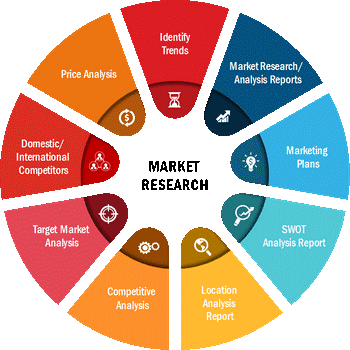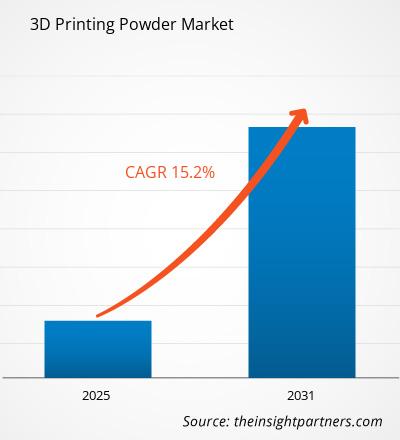3D プリンティング パウダー市場は、2022 年の 11 億 1,000 万米ドルから 2031 年までに 26 億 1,000 万米ドルに成長すると予想されています。 2022 年から 2031 年にかけて 15.2% の CAGR で成長すると推定されています。
3D プリントまたは積層造形では、プリンターは材料の粉末を使用します。粉末状の非晶質材料は、3D オブジェクトを作成するためのインクとして使用されます。 3D プリント プロセスは、粉末の微細な層を堆積することによって行われ、選択された設計断面に基づいてレーザー露光機に通され、粒子が溶けて一緒に焼結します。 3D プリントはさまざまな方法で行うことができますが、最も一般的なのは熱溶解積層法 (FDM) です。エンジニアとメーカーは、耐久性と機能性のあるアイテムを作成するために選択的レーザー焼結 (SLS) 3D プリントを利用しています。 3D プリント パウダーの成長 市場の拡大は、自動車、航空宇宙、防衛、ヘルスケア、歯科、消費者製品などのさまざまな分野での 3D プリンティング パウダーの採用の増加によるものと考えられています。
市場のダイナミクス >
3D プリンティング用の優れた積層造形技術に対するニーズの高まりが、3D プリンティング パウダーの需要を押し上げ、それが市場の成長を促進する主な理由です。さらに、自動車および自動車向けのアプリケーションが増加しています。航空宇宙分野と医療分野からの需要の高まりも、3D プリンティング パウダー市場の成長を推進しています。 3D プリンティング パウダーは、自動車分野のターボチャージャーに応用されています。 、ハウジングとブラケット、タイヤ金型、トランスミッション プレート、コントロール バルブとポンプ、冷却ベント、ダッシュボード、シート フレームのプロトタイピング、バンパー、ボディ パネル、その他のエンジン コンポーネント。さらに、ラピッド プロトタイピングのアプリケーションの増加a>、航空宇宙産業の需要も拡大しており、発展途上地域における自動車の技術進歩も、予測期間中の 3D プリンティング パウダー市場の需要を押し上げています。
市場範囲
「グローバル 3D プリンティング パウダー 2031 年までの市場予測」レポートは、詳細な市場セグメンテーションとともに市場の概要を提供することを目的としています。主要な市場プレーヤーのパフォーマンスに基づいた主要な統計を提供し、主要な傾向を提供します。
戦略的洞察
市場セグメンテーション
世界的な3D プリンティング パウダー市場は種類と用途に基づいて二分されます。種類に基づいて、市場は金属、プラスチック、セラミックなどに分類されます。用途に基づいて、市場は航空宇宙および防衛、自動車に分類されます。 、医療、その他。
地域フレームワーク
世界的な3D プリンティング パウダー市場は、北米、ヨーロッパ、アジア太平洋 (APAC)、中東およびアフリカ (MEA)、南および中央アメリカの 5 つの主要地域に分割されています。レポートでは、18 地域の分析と予測がカバーされています。
北米が 3D プリント パウダーを独占2021 年の市場。北米の技術的に先進的な新興企業や政府機関による 3D プリンティング産業への投資の増加により、予測期間中の市場の成長が促進されると予想されます。さらに、< a title="3D プリンティング市場" href="https://www.theinsightpartners.com/ja/reports/3d-printing-market" target="_blank" rel="noopener">3D プリンティング市場も 3D プリンティング パウダー市場を強化する可能性がありますさらに、開発コストの低下により、粉末ベースの 3D プリンティングの利用可能性が高まることに加え、耐久消費財、アクセサリー、装飾品などの他の用途でも、粉末ベースの 3D プリンティングの需要が増加すると予想されます。 3D プリント パウダー。
出典: Insight Partners 分析
市場。また、これらの地域の市場に影響を与える要因についてのポーターのファイブ フォース分析も提供します。
新型コロナウイルス感染症 (COVID-19) のパンデミックの影響
新型コロナウイルス感染症(COVID-19)のパンデミックは、多くの業界に深刻な影響を及ぼしました。ロックダウンの発動により、さまざまな製造活動が一時的に停止され、その結果、原材料の供給が減少し、3D プリント用パウダー市場に悪影響を及ぼしました。航空宇宙、石油、ガスから医療に至るまで、ユーザー産業はパンデミックにより妨げられました。しかし、医療機器や防護服の不足を克服するために、多くの国が 3D プリント製品を採用しました。 たとえば、米国食品医薬品局は 2021 年 9 月に、3D プリンティングなどの非伝統的な製造アプローチをサポートするために、NIH、VA、および America Makes と協力し始めました。低コストのデスクトップ 3D プリンタにより、経済的な 3D モデルとガイドですが、品質の承認が少ないです。
SARS-CoV-2 感染を初期段階で検出するには、検査のために鼻上皮粘膜を採取するための鼻咽頭 (NP) スワブが重要な機器でした。パンデミック中、鼻咽頭スワブの需要は予想外でした。 3Dプリンティング技術を利用して新しい綿棒の大量生産が行われた さらに、米国政府は医療機器や安全キットの製造に3Dプリンティング技術の使用を承認した 製薬業界からの3Dプリンティングパウダーの需要の増加が後押しすると予想される予測期間中の 3D プリンティングパウダー市場の成長。
市場参加者
さまざまな企業が、製品の発売、製品の承認、特許、イベントなどの有機的な成長戦略に焦点を当てています。市場で見られる非有機的な成長戦略活動には、買収、提携、コラボレーションなどがあります。これらの活動は、事業拡大と市場参加者の顧客基盤への道が開かれました。3D プリンティング パウダーの需要の高まりにより、市場参加者は今後数年間で大きな成長の機会を経験すると予想されます。
このレポートには、3D プリンティング パウダーを扱う主要な企業概要が含まれています。市場、SWOT 分析と市場戦略。また、企業概要、提供されるコンポーネントとサービス、過去 3 年間の財務情報、過去 5 年間の主な開発など、業界をリードする企業の情報にも焦点を当てています。
< p>3D プリンティング パウダーで事業を展開する主要企業マーケット- 日本ガス
- エラスチール < li style="カラー: rgb(33, 37, 41); 行の高さ: 通常; 背景: 白; margin-top: 0cm; margin-right: 0cm; margin-bottom: 8pt; font-size: 10pt; フォント-family: verdana, Geneva, sans-serif;">スタンフォード アドバンスト マテリアルズ
- Höganäs AB
- GKN シンター メタルズ エンジニアリング Gmbh
- Sms Group Gmbh
- アストロアロイズ株式会社
- エボニック インダストリーズ AG
- サンドビック AB
- Markforged
Insight Partner の専任の調査分析チームは、高度な統計専門知識を持つ経験豊富な専門家で構成され、既存の調査にさまざまなカスタマイズ オプションを提供します。

- 過去2年間の分析、基準年、CAGRによる予測(7年間)
- PEST分析とSWOT分析
- 市場規模価値/数量 - 世界、地域、国
- 業界と競争環境
- Excel データセット



Report Coverage
Revenue forecast, Company Analysis, Industry landscape, Growth factors, and Trends

Segment Covered
This text is related
to segments covered.

Regional Scope
North America, Europe, Asia Pacific, Middle East & Africa, South & Central America

Country Scope
This text is related
to country scope.
Trends and growth analysis reports related to Chemicals and Materials : READ MORE..
The List of Companies
1. Sandvik AB
2. CRS Holdings Inc
3. GENERAL ELECTRIC
4. ERASTEEL
5. EOS
6. Arkema
7. ExOne
8. Höganäs AB
9. GKN Sinter Metals Engineering GmbH
10. SMS group GmbH
11. Astro Alloys Inc
12. Stanford Advanced Materials
13. Metalysis
14. BASF SE
15. Evonik
16. voestalpine High Performance Metals Corp
17. Xi'an Sailong Metal Materials Co., Ltd.
18. Metal Technology Co. Ltd.
19. Markforged
20.PROTIQ
The Insight Partners performs research in 4 major stages: Data Collection & Secondary Research, Primary Research, Data Analysis and Data Triangulation & Final Review.
- Data Collection and Secondary Research:
As a market research and consulting firm operating from a decade, we have published and advised several client across the globe. First step for any study will start with an assessment of currently available data and insights from existing reports. Further, historical and current market information is collected from Investor Presentations, Annual Reports, SEC Filings, etc., and other information related to company’s performance and market positioning are gathered from Paid Databases (Factiva, Hoovers, and Reuters) and various other publications available in public domain.
Several associations trade associates, technical forums, institutes, societies and organization are accessed to gain technical as well as market related insights through their publications such as research papers, blogs and press releases related to the studies are referred to get cues about the market. Further, white papers, journals, magazines, and other news articles published in last 3 years are scrutinized and analyzed to understand the current market trends.
- Primary Research:
The primarily interview analysis comprise of data obtained from industry participants interview and answers to survey questions gathered by in-house primary team.
For primary research, interviews are conducted with industry experts/CEOs/Marketing Managers/VPs/Subject Matter Experts from both demand and supply side to get a 360-degree view of the market. The primary team conducts several interviews based on the complexity of the markets to understand the various market trends and dynamics which makes research more credible and precise.
A typical research interview fulfils the following functions:
- Provides first-hand information on the market size, market trends, growth trends, competitive landscape, and outlook
- Validates and strengthens in-house secondary research findings
- Develops the analysis team’s expertise and market understanding
Primary research involves email interactions and telephone interviews for each market, category, segment, and sub-segment across geographies. The participants who typically take part in such a process include, but are not limited to:
- Industry participants: VPs, business development managers, market intelligence managers and national sales managers
- Outside experts: Valuation experts, research analysts and key opinion leaders specializing in the electronics and semiconductor industry.
Below is the breakup of our primary respondents by company, designation, and region:

Once we receive the confirmation from primary research sources or primary respondents, we finalize the base year market estimation and forecast the data as per the macroeconomic and microeconomic factors assessed during data collection.
- Data Analysis:
Once data is validated through both secondary as well as primary respondents, we finalize the market estimations by hypothesis formulation and factor analysis at regional and country level.
- Macro-Economic Factor Analysis:
We analyse macroeconomic indicators such the gross domestic product (GDP), increase in the demand for goods and services across industries, technological advancement, regional economic growth, governmental policies, the influence of COVID-19, PEST analysis, and other aspects. This analysis aids in setting benchmarks for various nations/regions and approximating market splits. Additionally, the general trend of the aforementioned components aid in determining the market's development possibilities.
- Country Level Data:
Various factors that are especially aligned to the country are taken into account to determine the market size for a certain area and country, including the presence of vendors, such as headquarters and offices, the country's GDP, demand patterns, and industry growth. To comprehend the market dynamics for the nation, a number of growth variables, inhibitors, application areas, and current market trends are researched. The aforementioned elements aid in determining the country's overall market's growth potential.
- Company Profile:
The “Table of Contents” is formulated by listing and analyzing more than 25 - 30 companies operating in the market ecosystem across geographies. However, we profile only 10 companies as a standard practice in our syndicate reports. These 10 companies comprise leading, emerging, and regional players. Nonetheless, our analysis is not restricted to the 10 listed companies, we also analyze other companies present in the market to develop a holistic view and understand the prevailing trends. The “Company Profiles” section in the report covers key facts, business description, products & services, financial information, SWOT analysis, and key developments. The financial information presented is extracted from the annual reports and official documents of the publicly listed companies. Upon collecting the information for the sections of respective companies, we verify them via various primary sources and then compile the data in respective company profiles. The company level information helps us in deriving the base number as well as in forecasting the market size.
- Developing Base Number:
Aggregation of sales statistics (2020-2022) and macro-economic factor, and other secondary and primary research insights are utilized to arrive at base number and related market shares for 2022. The data gaps are identified in this step and relevant market data is analyzed, collected from paid primary interviews or databases. On finalizing the base year market size, forecasts are developed on the basis of macro-economic, industry and market growth factors and company level analysis.
- Data Triangulation and Final Review:
The market findings and base year market size calculations are validated from supply as well as demand side. Demand side validations are based on macro-economic factor analysis and benchmarks for respective regions and countries. In case of supply side validations, revenues of major companies are estimated (in case not available) based on industry benchmark, approximate number of employees, product portfolio, and primary interviews revenues are gathered. Further revenue from target product/service segment is assessed to avoid overshooting of market statistics. In case of heavy deviations between supply and demand side values, all thes steps are repeated to achieve synchronization.
We follow an iterative model, wherein we share our research findings with Subject Matter Experts (SME’s) and Key Opinion Leaders (KOLs) until consensus view of the market is not formulated – this model negates any drastic deviation in the opinions of experts. Only validated and universally acceptable research findings are quoted in our reports.
We have important check points that we use to validate our research findings – which we call – data triangulation, where we validate the information, we generate from secondary sources with primary interviews and then we re-validate with our internal data bases and Subject matter experts. This comprehensive model enables us to deliver high quality, reliable data in shortest possible time.

 このレポートの無料サンプルを入手する
このレポートの無料サンプルを入手する